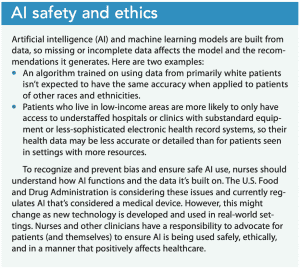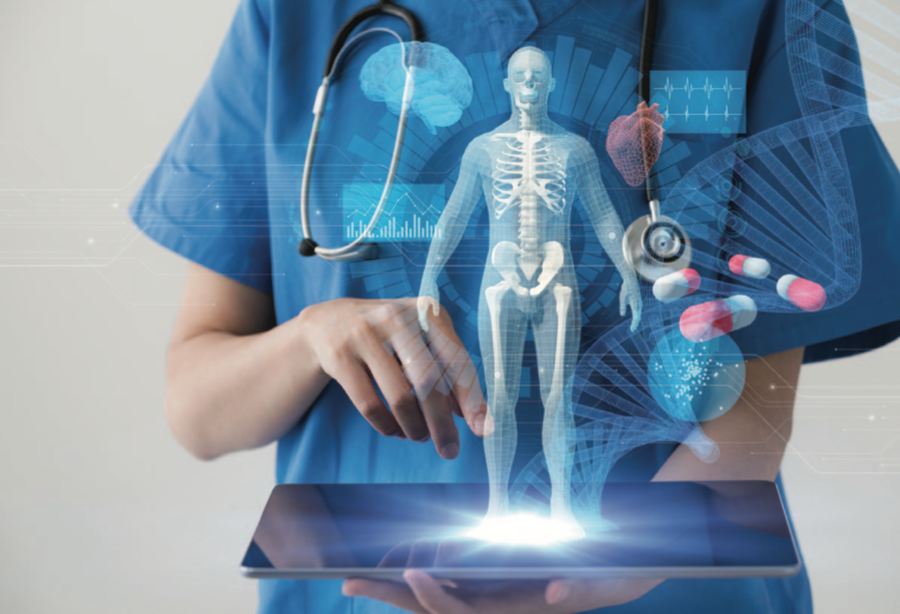Thinking about care in a new light.
Takeaways:
- Artificial intelligence (AI) is an umbrella term for several different technologies and methodologies that contribute to many advances in healthcare today.
- Nurses should have a basic understanding of AI so they may be informed users and contribute to their development.
According to Merriam-Webster, artificial intelligence (AI) is defined as a machine’s capacity to imitate intelligent human behaviors, such as reasoning and problem-solving. In healthcare, AI frequently refers to computer software programs designed to interpret data (for example, patient records, administrative claims, medical imaging, and data from mobile devices), learn from that data, and inform clinical and operational decision-making. In 2018, Becker’s Health IT reported that healthcare AI was valued at more than $2 billion and projected to exceed $36 billion by 2025. Investment in AI is increasing as healthcare organizations seek to improve care and lower costs.
Healthcare AI isn’t the stuff of science fiction; it uses computational algorithms with the electronic health record (EHR) as the data source. Although work is being done to develop “robotic clinicians” to automate human activities, this AI application isn’t common, nor is it the primary focus of research and development. In fact, the National Academy of Sciences urges researchers and industry leaders not to prioritize developing task-automation AI; instead, AI should be developed to support tasks and reduce clinician burden.
In this article, we’ll clarify what AI means in the context of healthcare today and provide examples of how AI currently is used to support nurses and the care they provide.
AI definitions and context
AI can be difficult to define. The primary reason for this ambiguity is the breadth of what AI encompasses—different industries focus on widely different applications, and the completely contextual nature of technology complicates its definition. In other words, AI shifts depending on the person or organization that provides the definition. For example, would you consider a simple calculator to be AI? Probably not. But what if we presented such a technology to someone 100 years ago? In other words, context matters.
In healthcare, we typically define AI as tools (such as machine learning, deep learning, and other applications) that autonomously transform clinical data into knowledge used by patients, clinicians, and family members to make decisions that otherwise couldn’t be efficiently accomplished. (See AI definitions.)
Machine learning, deep learning, and neural networks are at the heart of artificial intelligence (AI). These terms are sometimes used interchange- ably, which isn’t always correct. Simply put, machine learning, which also includes natural language processing, was the first term coined for au- tonomous computer learning, with deep learning and neural networks coming later as more advanced methods. For more definitions, click here.
| Term | Definition | Application examples |
| Machine learning | Machine learning is a type of AI that uses algorithms to analyze raw data and develop computer instructions to achieve objectives such as making predictions, recognizing speeches, translating text, and playing games. | • Disease (e.g., diabetes, heart disease) pre- diction • Early sepsis detection • Automated diagnosis from medical images (e.g., tumor recognition and staging) • Drug discovery • Disease outbreak detection • Personalized healthcare through genomics (e.g., drug therapy) |
| Deep learning | Deep learning is a subfield of ma- chine learning. A deep learning model is designed to reach the same conclusions as a traditional machine learning algorithm but does so with much less human input. To achieve this, deep learn- ing applications use a layered structure of model elements called an artificial neural network. | |
| Neural networks | Neural networks are composed of algorithms modeled after human thought processes. These networks are used to recognize patterns from large amounts of data, whether it’s alpha-numeric or images. | • Diagnosis confirmation • Clinical ontology/terminology development • Automated content/qualitative analysis • Use of Twitter data to detect flu outbreaks |
| Natural language processing | This machine learning field focus- es on developing computer algorithms that process and analyze unstructured text or speech data. |
Nurses and AI
Nurses deliver the best possible care by engaging in core practices such as assessment, planning, and outcome evaluation. Few nurses, however, possess an understanding of AI applications—including machine learning, deep learning, and natural language processing (NLP)—and their implications for nursing research and practice, as well as their potential role in improving patient care and health outcomes. (See AI safety and ethics.)
Machine learning
Much of the hype around AI in healthcare is due to the potential of machine learning. Simply put, machine learning refers to the use of a computer program to autonomously learn from data to perform a certain task. The “learning” refers to software self-adjustment that fine-tunes an algorithm over time to increase accuracy. The goal of the machine learning tool, and the data it has access to, is determined by its developer, but how the program uses the data isn’t known. This inherent uncertainty is called the “black box.”
Similar to any data-dependent tool, a machine learning tool’s function and use are only as good as its data sources. This is where nurses are needed. Nurses with a boots-on-the-ground perspective understand patient care and the information that’s required to make informed clinical decisions. Nurse input improves the applicability and accuracy of machine learning tools.


Nurses using AI and EHR data also have gained a sophisticated ability to read and translate signals into precision patient monitoring. For example, the SuperAlarm, an application developed by Hu, uses patterns of co-occurrences of individual alarms (such as arrythmia alerts and hemodynamic monitoring) to predict impending cardiopulmonary arrests. Hu demonstrated the ability to achieve 90% sensitivity in predicting when critical care patients would need resuscitation. This machine learning application is relevant to nursing because in addition to improving patient outcomes, it also reduces alert fatigue by combining alarm signals into less frequent, but significant usable information.
Deep learning
Deep learning, a subfield of machine learning, advances nursing using neural networks for advanced pattern recognition, which has helped machine learning extend to new sources of data, including speech recognition and image analysis. By integrating data from many sources, AI can be used to tailor treatments precisely to patients’ specific genes, lifestyles, and treatment preferences.
Deep learning applications can help nurses identify at-risk patients who would benefit from clinical interventions to prevent adverse health events, such as sepsis or hospital readmission. For example, Duke University researchers Theiling and colleagues created Sepsis Watch, which is trained via deep learning to analyze over 32 million data points to create a patient’s risk for developing sepsis. If the findings call for action, the hospital’s rapid response team is automatically alerted and guided through the first 3 hours of care administration.
Nurses may not be the primary users of imaging technology, but it significantly impacts patient treatment. Imaging advances using deep learning include detection (such as early or automated detection of neurologic abnormalities or cancer), characterization (staging or diagnosis), and monitoring (tumor changes over time). Many of these tools are as accurate as (or sometimes even more accurate than) humans and have potential for growth and increased adoption.
NLP
NLP is the analysis of EHR text data, rather than numbers or other countable elements. It can be used alone or in conjunction with machine learning methods and may contribute to other AI areas; for example, sentiment analysis could be used to determine how positive or negative a clinician or patient feels about a prognosis. Of all AI applications, NLP usually is cited as being the most difficult to adopt because of a lack of formal data intake and reporting. However, several promising applications currently in use affect patient care and health outcomes. In nursing, a valuable source of text data comes from nursing notes, which frequently are rich with clinical information. A wide variety of applications have been developed using nursing notes, including predicting emergency department patient disposition (Sterling and colleagues), uncovering patient financial barriers (Skaljic and colleagues), and predicting falls (Nakatani and colleagues).
In addition to research applications and subsequent decision support, NLP also may refer to voice recognition, such as that found in Siri or Alexa. In healthcare, voice recognition may help with note writing, information retrieval, and chart navigation. Speech recognition programs convert language to text, but NLP advancement may provide more sophisticated options.
Shaping the future of care
AI has the potential to help nurses improve the quality and efficiency of care, benefiting patients and clinicians. Feeling some angst during the expansion of AI is natural and reasonable, but as AI continues to mature, nurses will need to participate in ongoing open dialogue about its development and use in healthcare. Nurses will be the key to helping organizations implement and adapt to AI technology transformations as they participate in the development and evaluation of new applications that will shape the future of patient care.
The authors work at Duke University in Durham, North Carolina. Brian J. Douthit is a PhD student at Duke University School of Nursing. Xiao Hu is a professor in the departments of neurology and surgery in the school of medicine and the departments of electric and computer engineering and biostatistics and bioinformatics. Rachel L. Richesson is an associate professor in the school of nursing and the department of biostatistics and bioinformatics. Hyeoneui Kim is an associate professor in the school of nursing. Michael P. Cary, Jr., is an associate professor in the school of nursing and a member of the Duke Center for the Study of Aging and Human Development.
References
Beam AL, Kohane IS. Translating artificial intelligence into clinical care. JAMA. 2016;316(22):2368-9.
Bi WL, Hosny A, Schabath MB, et al. Artificial intelligence in cancer imaging: Clinical challenges and applications. CA Cancer J Clin. 2019;69(2):127-57.
Grady PA. National Institute of Nursing Research commentary on the Idea Festival for Nursing Science Education. Nurs Outlook. 2015;63(4):432-5.
Hermansson J, Kahan T. Systematic review of validity assessments of Framingham risk score results in health economic modelling of lipid-modifying therapies in Europe. Pharmacoeconomics. 2018;36(2):205-13.
Hu X. An algorithm strategy for precise patient monitoring in a connected healthcare enterprise. npj Digital Medicine. 2019;2(30). nature.com/articles/s41746-019-0107-z
Kumah-Crystal YA, Pirtle CJ, Whyte HM, Goode ES, Anders SH, Lehmann CU. Electronic health record interactions through voice: A review. Appl Clin Inform. 2018;9(3):541-52.
Matheny M, Israni ST, Ahmed M, Whicher D, eds. Artificial Intelligence in Health Care: The Hope, the Hype, the Promise, the Peril. NAM Special Publication. Washington, DC: National Academy of Medicine; 2019. nam.edu/wp-content/uploads/2019/12/AI-in-Health-Care-PREPUB-FINAL.pdf
Nakatani H, Nakao M, Uchiyama H, Toyoshiba H, Ochiai C. Predicting inpatient falls using natural language processing of nursing records obtained from Japanese electronic medical records: Case-control study. JMIR Med Inform. 2020;8(4):e16970.
Sendak M, Elish MC, Gao M, et al. “The human body is a black box”: Supporting clinical decision-making with deep learning. Paper presented at: Proceedings of the 2020 Conference on Fairness, Accountability, and Transparency; January 2020; Barcelona, Spain. doi.org/10.1145/3351095.3372827
Skaljic M, Patel IH, Pellegrini AM, Castro VM, Perlis RH, Gordon DD. Prevalence of financial considerations documented in primary care encounters as identified by natural language processing methods. JAMA Netw Open. 2019;2(8):e1910399.
Sterling NW, Patzer RE, Di M, Schrager JD. Prediction of emergency department patient disposition based on natural language processing of triage notes. Int J Med Inform. 2019;129:184-8.
Theiling BJ, Donohoe R, Sendak MP, et al. 2 Sepsis Watch: A successful deployment of a deep learning sepsis detection and treatment platform. Ann Emerg Med .2019;74(suppl 4):S1-2.
Velupillai S, Suominen H, Liakata M, et al. Using clinical natural language processing for health outcomes research: Overview and actionable suggestions for future advances. J Biomed Inform. 2018;88:11-19.
Wang L, Xue Z, Ezeana CF, et al. Preventing inpatient falls with injuries using integrative machine learning prediction: A cohort study. NPJ Digit Med. 2019;2:127. nature.com/articles/s41746-019-0200-3



















2 Comments.
Good experience
Good